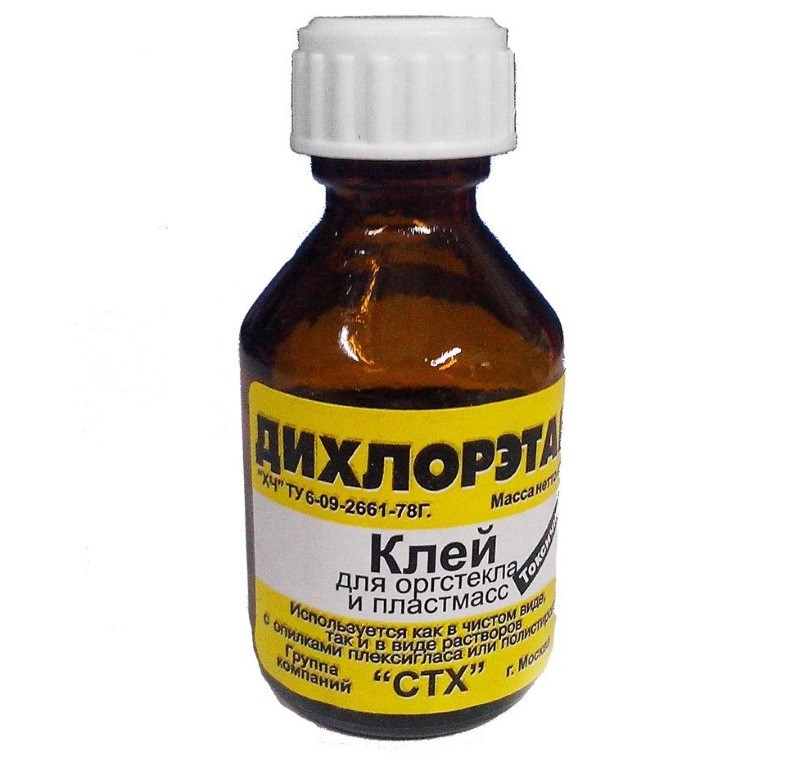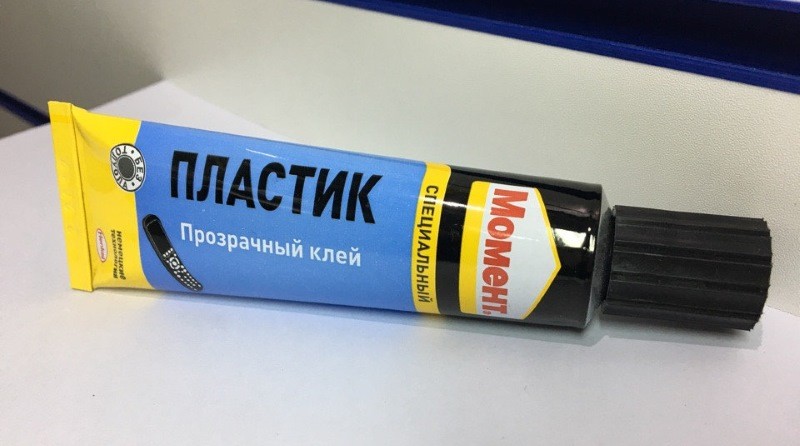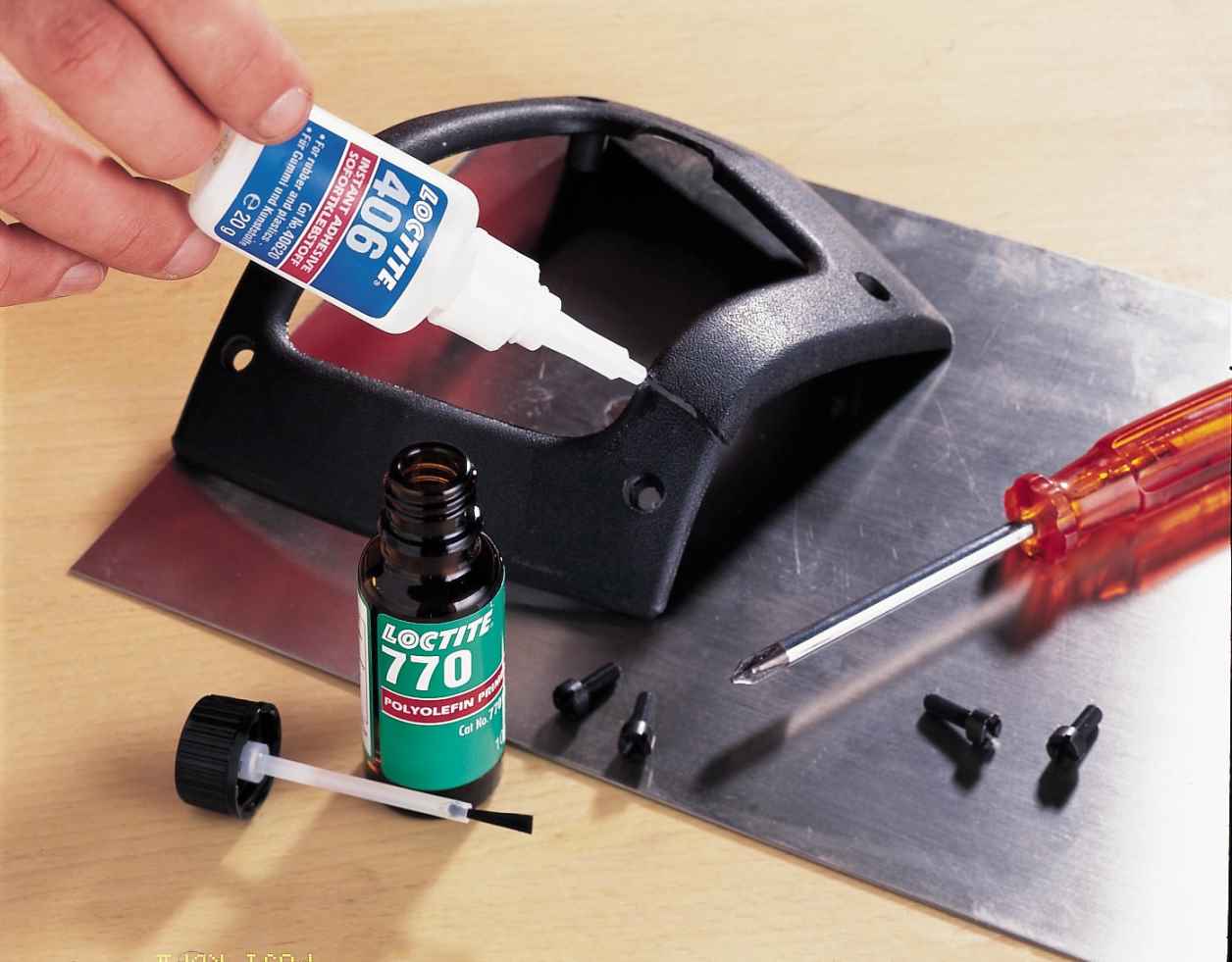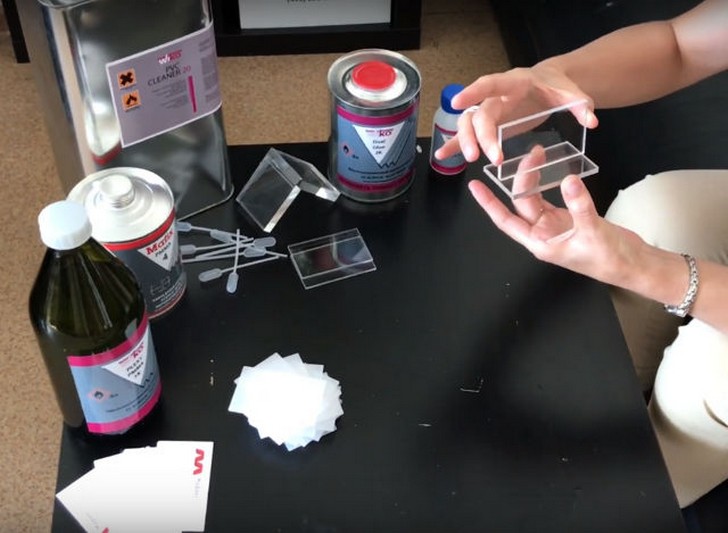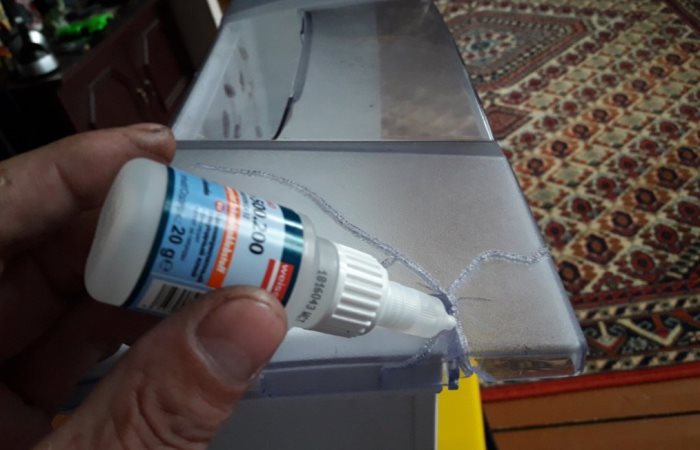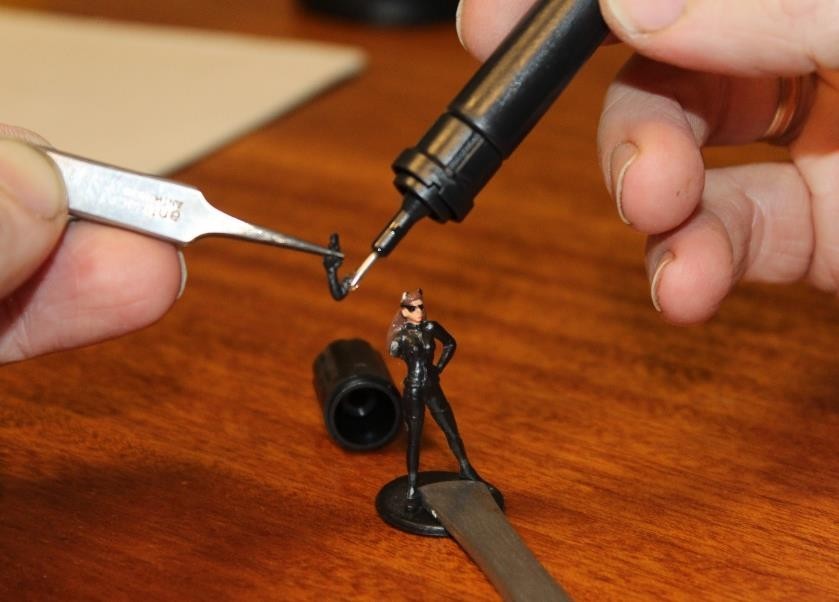PLA Adhesives - Choice of Available Options
For gluing PLA-plastic, you can use the following types of glue:
Dichloroethane (abbreviated name - DHE) is a universal adhesive (solvent) made in Russia. Reliably glues PLA and ABS plastics, as well as other hard-to-glue types of plastics. EDC itself is not a glue; for its preparation, it is necessary to dissolve a small amount of plastic in dichloroethane in advance. Disadvantages of this type of glue: it has a strong unpleasant odor, is poisonous.
Pla plastic can be glued with dichloroethane only in well-ventilated rooms, observing safety precautions.
It is unacceptable to use EDC for gluing food utensils. Dichloroethane is sold in small brown glass bottles with a volume of 30-50 ml, it costs about 50-70 rubles.

Moment Super is a universal water and heat resistant instant glue based on cyanoacrylate. Instantly bonds most types of plastics, including PLA plastic.
Adhesion occurs almost immediately after bonding the parts to be bonded under the influence of oxygen. Glue Moment Super is sold in small aluminum tubes of 3 grams each, it costs about 70-80 rubles.
COSMOFEN is a universal cyanoacrylate adhesive for a wide range of applications. The best results are shown when working with various types of plastics.
Cosmofen provides fast and reliable fixation of the parts to be glued. The glue is resistant to external weathering and is not afraid of water.
COSMOFEN cyanoacrylate glue is sold in 20 ml plastic bottles and costs about 180 rubles.
Types of glue for plastic
It is sometimes more difficult to glue materials made of synthetic polymers than ceramics and metals. The structure of the plastic is characterized by a smooth surface and therefore low adhesion. In industrial production, welding is used to connect plastic parts. Gluing plastic at home in this way is impossible, so repairs are carried out with glue.
The main component present in most adhesives is a special mixture that dissolves synthetic polymers. To give the formulations viscous properties, liquid polystyrene is added to them.
The principle of operation of such compositions is to dissolve parts of different surfaces. After squeezing them under pressure, there is a strong adhesion of the parts to be glued to each other.
Depending on the composition, all adhesives are divided into the following types:
- hot glue;
- contact;
- liquid;
- reactionary.
To figure out which glue is better to glue plastic, it is necessary to study the properties and characteristics of each type of glue.
Hot glue
Such bonding compounds are solid rods. To impart adhesion properties, they must be heated to a certain temperature. For this purpose, special pistols are used.
As a rule, hot melt adhesives are used in creative work, since they have a low bond strength and are poorly suited for performing precision work.
Hot melt adhesives can also be found in stores that are designed to be used without a gun. Their advantage is ease of use and fast hardening.
Contact
Those who are thinking how to glue plastic at home simply and quickly should pay attention to contact adhesives. Some of them come with a special hardener.
Getting started, you need to mix the two compositions according to the instructions on the package.
Such compositions are capable of rigidly connecting plastic parts, but they are highly toxic. You need to use contact adhesive for plastic, strictly following the instructions.
Before joining two parts with contact adhesive, you should wait at least 10 minutes until it dries, and only then press the two parts tightly together.
Liquid
Liquid substances are simple and affordable, but at the same time they have the lowest quality of connection of plastic parts. They can be water-based or solvent-based.
It is recommended to use them for working with small objects that will not be subjected to stress in the future. Liquid adhesives are not prone to destruction of the plastic structure
This is very important when working with small parts, as the glue that dissolves the plastic can deform them. They harden for a long time, therefore, after repair work, it is necessary to leave the glued parts for at least a day.
Reactionary
Such household compounds are considered the most reliable, and at the same time they are among the most affordable. It should be noted that many of them have their own peculiarities of application.
So, when working with some of them, the parts to be connected must be left to dry in the open air. Other formulations require exposure to ultraviolet rays, while others only work underwater.
Reaction adhesives can be:
- One-component.
- Two-component.
Both one-component and two-component plastic adhesive can include components such as polyurethane, epoxy resins, polyesters.
The main causes of damage
Defects on dentures occur for various reasons, which are associated with external influences or improper use. The repair of the damage depends on the specific cause.
Fall of the structure
Throughout the entire process of wearing removable dentures, you should avoid dropping them onto a hard surface. Often, the product is damaged by hitting the tile floor or sink during cleaning. Falling even from a low height can lead to the formation of chips and microcracks.
3> High load
In order not to damage the structure, you need to refuse to eat hard and too hard foods, including crackers and nuts. Solid food increases the load on the product and causes a defect.
Loss of an abutment tooth
If the structure is fixed in the oral cavity on the abutment tooth, its loss leads to the displacement of the product. As a result, the risk of denture defects is increased.
Operating errors
Violation of the basic rules for using a prosthesis is a common cause of damage. When it becomes necessary to install dentures, it is better to immediately familiarize yourself with the nuances of operation in order to avoid mistakes.
How to glue plastic to glass
Plastic is glued to glass mainly for the manufacture of souvenirs, doors, windows and other interior components. You can use polyurethane glue with primer, glass sealant glue with primer, titanium adhesives. Surfaces must also be treated before gluing. In all cases, strictly follow the gluing instructions.
Be sure to pay attention to what loads the connection will experience. If the gluing goes end-to-end and constant dynamic loads are foreseen, then consider the option of gluing through the anchor, as shown in the example in the video
Dental technician repair methods
When contacting a specialist, the repair method is determined after examining the damaged dental structure. To eliminate the defect, the use of specialized equipment and additional materials may be required. Each of the repair methods considered below has certain nuances of implementation and requires a professional approach.
Filling with plastic
To fill a crack in a prosthesis, dental technicians consistently perform a number of actions. Including:
- Before shaping the product, the surface is degreased with a monomer.The damaged area is then filled with molten plastic and the material is manually leveled.
- To ensure an even finish, dentists often use dental instruments with differently shaped thin bases.
- The surface of the plastic is covered with a moistened cellophane plate and placed in a dental press to fix the material.
- If there is excess plastic, they are cut along the border of the product.
- The structure is placed in a polymerizer that provides slow heating, boiling and cooling. This method of polymerization reliably bonds the plastic to the base and has a positive effect on the final quality.
Dental resin
With the help of dental resin, the damaged area is built up. The specialist selects a composite material of a suitable shade and applies it to the place of a chip or crack. Resin build-up is convenient for chipping a small piece of the denture.
Wax
The wax is intended for modeling facets, crowns and other parts of fixed dentures. The composition for working with dental products is created on the basis of paraffin, natural resin and natural wax. The advantages of the material include:
- low heat shrinkage;
- ash content up to 0.02%;
- easy modeling with dental instruments;
- formation of dry and non-viscous chips.
Laser welding
The laser solderless welding process creates a tear-resistant bead with improved twist, displacement and bending characteristics compared to a solder bead. The technology excludes the occurrence of cracks and deformation of the product, ensuring high precision of adhesion of individual parts.
Single tooth restoration
Artistic restoration of an individual tooth is a set of measures that help eliminate aesthetic errors. The result of the restoration is a change in the irregular shape of the teeth, correction of their position, filling the interdental space, and a change in the shade of the enamel. After restoring the tooth, you can partially or completely get rid of the prosthesis.
In case of fracture of the clasp or fastening lock
Clasp systems and fastening locks mechanically hold the dentures in one place, preventing displacement. The breakdown of one of the parts requires a complete replacement, since broken small mechanisms are rarely repairable.
What glue is right
Dental constructions can be restored using adhesive solutions. For this purpose, special compositions have been developed that differ from simple glue.
Pharmacy products
The standard option for repairing dental products is to use a pharmacy product. This category includes several types of glue, so you should familiarize yourself with their characteristics before buying.
"Protacril"
"Protacryl" is produced in the form of a powder-liquid and, after mixing the components, turns into a self-hardening mass. The use of Protakril glue improves the physical and mechanical properties of the prosthesis and prolongs their service life. The color of the composition mimics natural fabrics.
"Redont"
Transparent glue "Redont" adheres well to the base material and dries quickly after application. By combining "Redont" with concentrates and dye, it is possible to give the solution the required shade.
"Coracril"
Cold-curing acrylic plastic "Coracryl" is used to fill cracks and build up damaged structures. The substance is distinguished by increased indifference to biological objects, since after drying, there is practically no monomer in the mass.
R.O.C.S
A joint development of Swiss and Russian manufacturers is used to fix dentures. When interacting with liquid, the composition hardens in 10-15 seconds and forms an airtight layer between the prosthesis and the gum.The use of the solution allows you to painlessly consume cold and hot food, without fear of damage to the dental structure.
"The Rocks"
Rox glue reliably fixes the prosthesis for 12 hours, preventing inflammation of the palate and gums. The constant use of the composition allows you to protect the prosthesis from external influences. The presence of minty ingredients ensures fresh breath throughout the day.
"Lakalut"
The substance of the Lakalut brand with a creamy consistency provides strong fixation without affecting the bite and taste of food. A significant advantage of Lacalut cream is to protect the gums from inflammation. After applying the composition, it fills the space under the product, which prevents the risk of food particles entering there. The formed elastic layer fixes the removable structure for a day.
Fittident
The Fittident glue, created on a water-insoluble basis, fixes the product for 10-12 hours. The presence of the substance gives a sense of the natural presence of the prosthesis during communication and eating.
"Protefix"
It is recommended to choose the fixing adhesive "Protefix" for people with increased salivation. When applied, the substance forms a protective layer that lasts for 12 hours and prevents food from getting under the installed prosthesis.
"Korega"
Means "Korega" creates a soft and elastic layer on the surface of the denture to protect it from food. Depending on your own wishes, you can purchase the composition in the form of adhesive strips, cream, powder or gel. Korega glue fixes the removable structure in the oral cavity for 24 hours.
Using super glue
Having noticed damage to the denture, many people think about using ordinary superglue as a means to restore. Despite the fact that superglue is able to firmly connect parts of the dental structure, it has a toxic effect on the body.
What formulations can not be used
To repair dentures, you need to use only specialized compounds that do not harm dental structures. Household and industrial adhesives do not have the desired characteristics and negatively affect the human body.
First you need to determine the brand of plastic
Before starting the bonding process, you need to know the brand of plastic from which the product is made. Having learned the type of plastic, you can choose the right effective adhesive.
Plastic sellers label their product with the recycling symbol triangle with arrows on the sides, which indicates the recycling of raw materials.
In symbolism, numbers from one to seven. Usually, numbers are supplemented with an abbreviation. From them you can find out the type of plastic. For strong adhesion of plastics, it is necessary to carefully consider the labeling of the product in order to apply the adhesive that will best suit the plastics in this group.
There is also another method for recognizing the type of plastic. Its essence is to heat a small part of a plastic product before burning. Different types of plastics burn with a special kind of flame and a remarkable smell. This method requires a lot of experience and skill.

The best waterproof adhesives for plastic
Waterproof compounds are used for gluing surfaces that are constantly exposed to moisture. The funds are often used to repair PVC connecting pipes, kitchens, bathrooms. They adhere firmly, dry quickly, and allow the surface to be used for its intended purpose in a few hours. In the composition of such funds there are some harmful substances, therefore they are not recommended to be used for repairing products with which human skin comes into daily contact.
Only 3 waterproof adhesives are selected for the rating. They passed a full selection, in which 7 items were evaluated. The selected list of products is characterized by high strength, quickly adheres to the surface, does not cause allergies when in contact with it.
Contact
Chinese waterproof glue is made on the basis of synthetic thermoplastic elastomers, which are designed for bonding plastic, as well as for repairing shoes, leather and rubber. It is produced in a minimum volume of 30 ml, is consumed economically, does not have a pungent odor. The product is durable, elastic, dries quickly. Full curing requires 24 hours, after this time the material can be used for its intended purpose, without fear for its integrity and safety. After drying, it acquires a plastic, transparent appearance, does not worsen the external condition of the material being repaired. Contact adhesive for plastic contains harmful components, therefore, during its use, it is advisable to wear a mask on the face in order to avoid direct contact of the nasal mucosa and its substances.

Advantages:
- Reliable fixation;
- Copes with its functions;
- Affordable price;
- Economical consumption;
- Perfectly glues any plastic.
Disadvantages:
Chemical composition and smell.
As customer reviews show, the product is used for thorough bonding of any kind of plastic, it comes into activity in a few minutes. A more lasting result is observed within a day. It is recommended to work with gloves and a mask to avoid negative effects on the skin and nasal mucosa.

The best adhesives for wood
Moment 88
The water-resistant composition is used for bonding rubber, metals, glass, ceramics, polystyrene. It will be ineffective in the reconstruction of dishes, styrene, polypropylene. The unique plastic glue formula is able to firmly glue the material, ensuring its durability, practicality and safety in use. It is characterized by particularly strong properties, due to which it is used in many industries, as well as in household work. It has a moderately pronounced odor, which disappears in just a few minutes upon the first contact with the surface. After a day, it is completely neutralized without creating any discomfort.

Advantages:
- Perfect bonding;
- Dries quickly;
- Used for many surfaces;
- Easy to apply;
- Good tenacity.
Disadvantages:
Gives off a strong odor.
Most reviews indicate that the moisture resistant glue does its job, safe when used correctly. Some consumers recommend interacting with it outdoors, since in an enclosed space it can create a pronounced unpleasant odor and provoke dizziness.
Second
A multi-purpose adhesive is used to bond any surface made of plastic material. It has a convenient, slim dispenser that helps to dispense a minimal amount of product onto the surface. The product is resistant to water and high humidity, it is also used for outdoor use, does not decompose under the influence of snow and rain. If you have no idea what kind of glue to glue the plastic, "Secunda" will be an excellent option. It is colorless, does not have a pronounced odor, you can interact with it even indoors. A 30 ml tube is enough for multiple uses. In addition to plastic, it perfectly adheres to rubber, leather, and is used to repair shoes.

Advantages:
- Low price;
- Suitable for many materials;
- Does not have a pungent odor;
- Convenient to use;
- Transparent view.
Disadvantages:
Dries up if not used.
Epoxy glue for plastic is applicable for frequent use; when opened, it cannot maintain a liquid state for a long time. When using it, there is no pungent odor, it does not cause allergies, it is considered one of the most practical and affordable gluing agents.
What affects the adhesion reliability?
It should be understood that in the repair of plastic products, an important role is played not only by the answer to the question, what is the best way to glue the plastic, but also by a number of other factors. It has already been mentioned above that each type of plastic requires its own bonding agent.Although there are a number of other points that directly affect the quality of gluing:
- material properties - this includes not only the novelty of the object, but also the wettability, the indicator of solubility, structure, molecular polarity, whether any modification was carried out with plastic;
- adhesive properties - an indicator of cohesive strength, structure, molecular polarity, rheological properties, wettability
- technological and design properties;
- in what mode the item will be used in the future;
- whether all the recommendations for preparing the plastic for bonding have been followed.
Of course, if the need arises to fix a simple toy or photo frame, then no one will figure out the molecular polarity. But when the question concerns more serious things, for example, water pipes, then here it is already necessary to approach the solution of such a problem more seriously.

In fact, it is not difficult to glue the plastic together. But for the fastening to be really reliable, you need to choose the right glue for the existing plastic. Only in this case, the previously broken thing will serve its owner for some time.
In everyday life, many faced such a problem as broken plastic products. These items rarely lend themselves to any kind of DIY repair, it is safer to glue them. You can decide how to glue the plastic tightly by considering the best adhesives for different types and gluing technology.
Adhesive for plastic (click to enlarge)
Before gluing the plastic, it is important first of all to determine the type of material of the broken item. This is important to do in order to better glue the plastic and not damage the product - many adhesives are solvents for plastic parts
Most often, a manufacturer marks its products with a recycling symbol, which can be used to determine the type of plastic. It is a triangle with drawn arrows on the edges, inside there are numbers from 1 to 7.
Another designation of the brand is the alphabetic characters inside or next to the triangle. Knowing these designations, you can determine the type of plastic, after which the adhesive for plastic is suitable for it.
Marking
1 or PET is polyethylene terephthalate. The main area of application is food packaging. It is used in the manufacture of artificial fibers, plastic packaging for liquid food products, films.
2 or HDPE - high density polyethylene with low pressure technology. It is used in the production of shrink films and bags for packaging.
3 or PVC - polyvinyl chloride (PVC) is used in the manufacture of linoleum and plastic windows.
Watch the video to find out more:
4 or LDPE - low density polyethylene with high pressure technology. Food-grade plastic, bags, wrappers and bottles, greenhouse films, packaging containers, toys for children, pipes are made of it.
5 or PP - polypropylene, due to its inertness and heat resistance (it can be kept under hot steam and boiled), is widely used in the production of food packaging. The material is widely used in medicine (disposable syringes, catheters), in the production of household appliances, heat-resistant dishes and plastic pipes for hot water supply.
6 or PS - polystyrene. This type is used to make disposable dishes (cups for food products), inner plastic sheathing of refrigerating devices. When foaming polystyrene foam, a porous insulating material (foam) is obtained, which is widely used in construction and production.
7 or O (Other) - non-recyclable materials (combine a combination of foil, paper and polymer materials) or not included in the previous groups.
Operating rules
Compliance with the rules of use helps to reduce the likelihood of damage to the prosthesis. These include the following:
- The removable structure is cleaned twice a day with a special brush with paste.It is also recommended to cleanse after meals whenever possible.
- If the bridge of the structure bursts or the artificial tooth itself is cracked, it is immediately repaired so that the condition of the product does not deteriorate.
- When the product is displaced in the oral cavity, the position is corrected or a new design is installed. Displacement can occur at any time due to loosening of the fixing components.
Adhesive for plastic: the best tools
In the rating of good adhesives for plastics, there are domestic and foreign brands, and there are several categories of products on the market.
The best superglue for plastic
Working with superglues will be the fastest; it is easiest to repair small products at home with such compounds. Here is a list of popular remedies:
- "Super Moment" (100 rubles). Provides reliable adhesion of different types of plastic, suitable for solving difficult tasks, quickly sets. The packaging is comfortable, the spout is elongated. The adhesive is also suitable for ceramics, metal, glass.
- "Power of Superglue" (50 rubles). Made in China, it tightly bonds a variety of materials, including polymeric ones. Dot application is possible, which reduces consumption. The joint strength is more than 175 N. Among the minuses, the liquid consistency of the gel should be indicated.
- Econ Express (35 rubles). This glue is also produced by a Chinese manufacturer. It sets instantly and is suitable for all kinds of materials. The strength of the seam is 210 N, which is an excellent indicator at this price.
- Permatex Super Glue (130 rubles). The American line-up is often recognized as the winner in various nominations. The load on the glue can be up to 245 N, in which it surpasses its analogues. The tool can be used for the thinnest products, hard-to-reach areas.
- Cosmoplast 500. Composition based on cyanoacrylate is used in everyday life and in industry for the processing of any plastic products. With its help, seals are glued to the windows, end cuts are connected. Can serve as a sealant.
- UHU Plast. The glue is used for plastic and modeling, has a convenient needle tip. Provides a cold weld effect on machined surfaces.

Determine the type of plastic
First you need to deal with the material itself, which is to be repaired. Each type of plastic requires its own connection, so you need to determine the type. Typically, the manufacturer of the product marks it with a recycling mark. It is placed on the label, packaging, or the item itself. This sign is familiar to everyone - a triangle of 3 arrows. There is a number or letter on the outside or inside of such a designation.
Knowing the meaning of the marking, you can also pick up the glue that can hold this plastic together:
- 6 (PS) - polystyrene - repairs should be carried out using plastic cement, cyanoacrylate or epoxy glue (Super glue for plastic, Loctite);
- - 2, 4 or 5 (HDPE, LDPE, PP, or UMHW) - polyethylene or polypropylene - gluing can only be done with Loctite or Scotch Weld DP 8010;
- - 7, 9 (ABS) - a mixture of plastic resins - you need to take cyanoacrylate or epoxy glue.

Of course, it also happens that the product does not have any designations. Then you can try to remember what kind of plastic and what is most often made. For example, for Lego parts they use ABS material, and polystyrene is used for artificial glass, cheap toys, CD cases and other similar non-durable things. Then, in the first case, an epoxy connector is required, and in the second, polycement. When it becomes necessary to repair stronger things, for example, a bucket, bottle or box, then the issue must be solved with the help of adhesives designed for polyethylene or polypropylene.
Why is it so important to choose the right adhesive for a specific type of plastic? The fact is that such a tool may not only fail to connect the parts, but also simply spoil them by “melting” the shape of the plastic.Therefore, in order not to ditch the thing, you first need to clarify what material it is made of, so as not to make a mistake in the selection of glue

